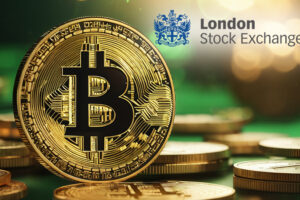ETN and ETF - how do they differ from each other?
ETN (Exchange Traded Notes), due to its name confusingly similar to ETF (Exchange Traded Funds), is often confused or even considered the same instrument as the ETF. Despite numerous similarities, these are completely different investment products. How exactly is an ETN different from an ETF?
What is ETF
To begin with, let's recall in a few words what an ETF is. It is a listed fund whose task is to faithfully reproduce the prices of selected assets. It can be a sector of the economy, an index, or the entire economy of a country. ETFs, in their assumption, are passively managed funds whose task is only to faithfully reproduce the basket of assets. Therefore, they are characterized by low management costs.
Check it out: Introduction to investing in ETFs
ETN - No Physical Replication
ETFs to faithfully reproduce selected instruments usually purchase them physically, i.e. if we have ETFs on gold, it has physical gold (e.g. [PHYS] Sprott Physical Gold Trust) or at least has gold futures. If we have ETFs on US tech companies, he has a basket of US tech stocks (NP. [IYW] iShares US Technology ETF).
In the case of ETN, the situation is different. The ETN does not physically buy the assets it wants to mirror. It only makes virtual calculations based on the price movements of the underlying instruments. As a result, the ETN has lower maintenance costs and is therefore cheaper for the customer. Thanks to the synthetic approach, the price of the benchmark is almost perfectly reflected, in the case of ETFs there are sometimes minor inaccuracies.
Check it out: ETF - Physical or synthetic replication?
ETNs are debt instruments
The main difference between an ETF and an ETN is that an ETF is a publicly traded investment fund, while an ETN is a debt instrument, also listed on the stock exchange.
The principle of operation of ETNs resembles bonds, which are also debt instruments. By buying both bonds and ETN, we lend money to the issuer, which he then undertakes to return according to the agreed rules. In the case of bonds, when making a purchase, we know what the return on investment will be - the interest rate is fixed and fixed. In the case of ETN, the return on investment depends on the movement of the instruments whose price is replicated by ETN.
Additionally, ETNs belong to unsecured bank securities, i.e. they are not guaranteed by the Bank Guarantee Fund. If the issuer of our ETN becomes insolvent, we will not get a refund of our invested money. For this reason, when choosing ETNs, it is particularly important to be guided by the credibility of the issuer.
This was the case during the 2008 financial crisis. Even though the value of ETNs for precious metals continued to increase, after the bankruptcy of Lehman Brothers, the ETNs issued by this bank became worthless due to its insolvency.
How to check the risk of the issuer's insolvency?
One method to make sure that the issuer from which you want to buy ETNs is solvent is to track the price of the CDS (Credit Default Swap). CDS is insurance against the bankruptcy of a given entity. If the price of a company's insolvency insurance remains constant, low, we can rest assured. However, if the cost of CDS per company or bank suddenly grows, it is a signal that the institution is struggling with problems that increase the risk of its bankruptcy.
ETNs are dominated by raw materials
Most of the ETNs available on the market are instruments that mimic the prices of goods and raw materials. They are usually based on futures contracts for a given commodity, selecting various series of contracts to minimize the contango effect.
contango
Contango effect is most associated with the market oilhowever, it is present with all raw materials. Raw materials, unlike non-physical assets, require storage and transportation. This generates costs that exceed their actual price. Therefore, commodity futures prices exceed the prices of the underlying asset. The closer to the expiry date of the contract, the smaller the price difference (the closer it is to the physical delivery of the raw materials, so storage and transportation costs decrease).
If the price of the raw material does not increase while we have a futures contract, it will not cover the costs of storing and transporting the raw material. Then, even if the price of the raw material did not drop, but remained at a constant level, we will record a loss and this is what we call the contango effect.
ETN and futures
Most ETNs are products that reflect commodity futures prices. Commodity futures contracts have a high investment threshold and are difficult to acquire for the average investor. ETNs allow you to enter the commodity market with lower capital than in the case of direct investments in futures. They also give the opportunity to play on declines in commodity prices and to make leveraged investments with the use of financial leverage, which is their undoubted advantage.
Where to find information on ETF and ETN?
The largest catalog of ETFs and ETNs available on the market is the website etf.com. There, we can browse these investment products by sector and learn a lot of valuable information about them.
ETF and ETN - similarities and differences
Finally, I present a table summarizing the differences and similarities of ETF and ETN instruments.
| ETF | ETN |
| the investment fund | Debt instrument |
| No credit risk | Credit risk in the event of the entity's insolvency |
| Physical or synthetic replication | Synthetic replication |
| Simple structure | Complex structure, frequent use of leverage and inverted positions |
| Susceptible to replication errors | Thanks to synthetic replication, perfect price mapping |
| Medium and long-term nature | Short-term nature |
| Low or medium investment risk | Medium or high investment risk |
| Listed on stock exchanges | Listed on stock exchanges |
| It reflects the price movements of selected instruments | It reflects the price movements of selected instruments |
| Continuously quoted | Usually quoted continuously |
Where to buy ETFs and ETNs?
To buy ETFs and ETNs, we need to set up an account in a brokerage house that offers the possibility of trading on the New York Stock Exchange.
The Polish stock exchange also offers several ETFs, but their liquidity and investment attractiveness are so far very low. ETF and ETN currently dominate the American stock exchange and they are worth trading there.






















![Forex Club – Tax 9 – Settle tax on a foreign broker [Download the Application] Forex Club - Tax 9](https://forexclub.pl/wp-content/uploads/2024/02/Forex-Club-Podatek-9-184x120.jpg?v=1709046278)
![Trading View platform – solutions tailored to the needs of traders [Review] trading view review](https://forexclub.pl/wp-content/uploads/2024/03/trading-view-recenzja-184x120.jpg?v=1709558918)
![How to connect your FP Markets account to the Trading View platform [Guide] fp markets trading view](https://forexclub.pl/wp-content/uploads/2024/02/fp-markets-trading-view-184x120.jpg?v=1708677291)
![How to invest in ChatGPT and AI? Stocks and ETFs [Guide] how to invest in chatgpt and artificial intelligence](https://forexclub.pl/wp-content/uploads/2023/02/jak-inwestowac-w-chatgpt-i-sztuczna-inteligencje-184x120.jpg?v=1676364263)


![WeWork – the anatomy of the collapse of a company valued at $47 billion [WeWork, part II] wework bankruptcy story](https://forexclub.pl/wp-content/uploads/2024/04/wework-bankructwo-historia-184x120.jpg?v=1711729561)
![Adam Neumann – the man who screwed up Softbank [WeWork, part AND] adam neumann wework](https://forexclub.pl/wp-content/uploads/2024/04/adam-neumann-wework-184x120.jpg?v=1711728724)





![How to transfer shares to another brokerage office [Procedure description] how to transfer shares to another brokerage house](https://forexclub.pl/wp-content/uploads/2024/03/jak-przeniesc-akcje-do-innego-biura-maklerskiego-184x120.jpg?v=1709556924)

![The most common mistakes of a beginner trader - Mr Yogi [VIDEO] Scalping - The most common mistakes of a beginner trader - VIDEO](https://forexclub.pl/wp-content/uploads/2024/03/Scalping-Najczestsze-bledy-poczatkujacego-tradera-VIDEO-184x120.jpg?v=1711601376)
![Learning patience: No position is also a position - Mr Yogi [VIDEO] Scalping - Learning patience - No position is also a position - VIDEO](https://forexclub.pl/wp-content/uploads/2024/03/Scalping-Nauka-cierpliwosci-Brak-pozycji-to-tez-pozycja-VIDEO-184x120.jpg?v=1710999249)
![When to exit a position and how to minimize losses - Mr Yogi [VIDEO] Scalping - When to exit a position and how to minimize losses - VIDEO](https://forexclub.pl/wp-content/uploads/2024/03/Scalping-Kiedy-wyjsc-z-pozycji-i-jak-minimalizowac-straty-VIDEO-184x120.jpg?v=1710336731)





![How to invest in ChatGPT and AI? Stocks and ETFs [Guide] how to invest in chatgpt and artificial intelligence](https://forexclub.pl/wp-content/uploads/2023/02/jak-inwestowac-w-chatgpt-i-sztuczna-inteligencje-300x200.jpg?v=1676364263)












